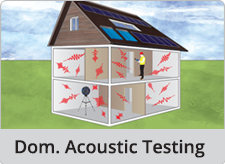Offices Nationwide

Air Testing & Leakage
Our engineers use Thermal camera and extensive knowledge of buildings to help find leakage areas within the building and can advice of these.

Sound Insulation
Two parameters describe sound insulation; Dw and Rw. Dw is the insulation between rooms. Rw is the lab-tested insulation of a wall/floor...more
Thermal Bridging And Airtightness
Enhanced Construction Details

Menai Bridge - Asbestos Management Survey - 01407 320 107
The office that covers this area is: Anglesey
Phone Number: 01407 320 107 Email: menai-bridge@e2consultants.co.uk
Asbestos_Survey is sometimes referred to as Fire Risk Assessment, Fire Risk Assessment, Fire Risk Assessment, Fire Risk Assessment, Fire Safety.
What's Involved In An Asbestos Survey?
For a refurbishment/demolition, or type 3, survey, a more destruction method is used over a management survey, as the name suggests. One of our asbestos surveyors will use means such as drilling floor slabs or knocking through walls to access areas where planned work will be undertaken. This ensures that when the building is converted of knocked down that the next team in won't risk running into any asbestos that could be hazardous to their health and slow the project.
An asbestos management, or type 2, survey will have one of surveyors taken samples of suspected asbestos throughout a building before sending them off to a lab. Whilst at the property, each room and the materials used will be noted. If a room is locked or otherwise inaccessible this will be noted too as there will remain a possibility of asbestos within.
Surveyor Qualifications
Each member of our asbestos team are holders of the BOHS (British Occupational Hygiene Society) P402 qualification - the statutory proficiency certificate in 'Building Surveys and Bulk Sampling for Asbestos'. Our experienced and professional consultants are here to help so if you have any queries please call us on 01407 320 107 or send your query to Asbestos-Survey@e2consultants.co.uk.
We're qualified in asbestos refurbishment, management and demolition surveys for industrial, commercial and domestic buildings covering Menai Bridge. Where required can also undertake a Commercial EPC in a cost-effective package.
What Is Asbestos?
The trade and use of asbestos has been restricted or banned in many jurisdictions in Menai Bridge. Asbestos is basically a set of six naturally occurring silicate minerals used for their desirable physical properties. Though mined from rock, when broken down it breaks apart into tiny fibres.
There are 6 types of asbestos - but only 3 have been widely used in building materials: white (Chrysotile), brown (Amosite) and blue (Crocidolite). Strictly speaking blue is the most dangerous, followed by brown and then white.
Where Can Asbestos Be Found?
- Toilet cisterns can contain asbestos-reinforced resin materials
- Insulation in floor and wall cavities, lofts and insulating boards
- Artex or similar decorative / textures coating on ceilings and sometimes walls
- External / internal wall panelling particularly around windows
- Water tanks can be made from asbestos cement and is often found in pre-1980 houses
- Flash Guards on fuse wires and panelling behind fuse boxes
- Sprayed fire insulation
- Floor tiles, mastics and sealants
- Pipe works, boilers, ducts and heat exchanges
Asbestos Legislation
The Control of Asbestos Regulations 2012 (Reg 4) places an explicit duty on those responsible (the duty holder) for any commercial premises to identify and manage asbestos containing materials that may be present in the property.
Employers must undertake risk assessments before commencing work which exposes, or is liable to expose, employees to asbestos. This risk assessment must include:
- A plan of work detailing how the work is to be carried out
- Indication of any asbestos-related issues
- Provide solutions to these issues
- How to prevent exposure to asbestos or reduce it to as low a level as is reasonably practicable
Our other services include:
Asbestos Management Survey can also be known as:
Commercial P402R Asbestos Survey, Asbestos Demolition Survey, Commercial Asbestos Demolition Surveys, Commercial Asbestos Refurbishment Survey, P402R Asbestos Survey, Commercial P402 Asbestos Survey, Commercial Asbestos Survey, Asbestos Refurbishment Survey, P402 Asbestos Survey, Commercial Asbestos Management Survey, Asbestos Survey,


Copyright 2025 E2 Specialist Consultants Limited
Company No. 06728970








































